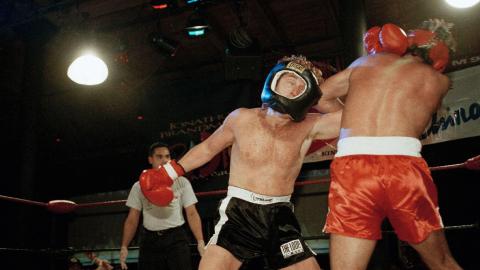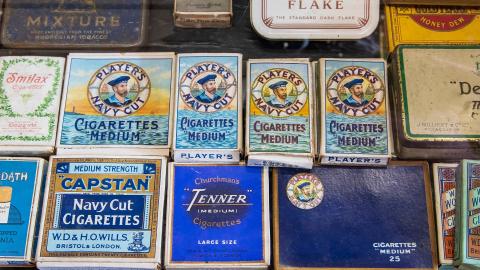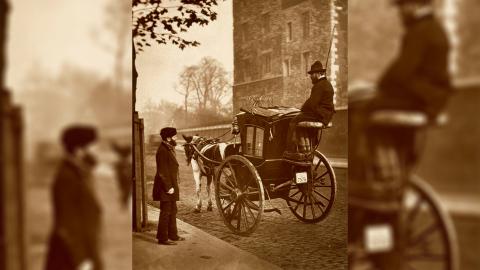The cautionary tale of Typhoid Mary, the original super-spreader
As the coronavirus is declared a global pandemic and governments hammer home the importance of washing our hands, the tale of a stubborn Irish cook who refused to wash hers has never seemed more relevant. Here was a woman whose dreadful personal hygiene led to a fifteen-year spree of typhoid outbreaks that could have been prevented with the simple application of soap and water. This is the story of ‘Typhoid Mary’.
Born in the small town of Cookstown in Northern Ireland, Mary Mallon was in her early thirties when she emigrated to the United States. In 1900, Mary was accepted on to the books of a New York domestic servant employment agency and soon took up a position with an affluent family in a rented summer house in the small town of Mamaroneck in New York State. Toward the end of August, a young man came to visit the family, and by the 4th of September he had come down with typhoid fever. Mary’s bacteria-infested cooking had claimed its first victim.
In 1901, she spent eleven months working for a family in New York City. Within days, several family members began displaying symptoms of typhoid fever, and a laundress working for the family was admitted to the Roosevelt Hospital where she subsequently died.
Infections followed Mary wherever she went.
1902 saw Mary working for a wealthy lawyer called Coleman Drayton in his summer house in Dark Harbor, Maine. Two weeks after Mary’s arrival at the house, the first case of typhoid appeared, quickly followed by six others in a household of nine. Only Drayton and Mary did not succumb to the illness.
Mary and Drayton worked side by side tending to the sick during the outbreak. Indeed, Drayton was so impressed with the Irish cook’s dedication to his stricken family members and servants, he rewarded her with a fifty-dollar bonus on top of her wages. Not a bad result for the woman who had made everybody ill in the first place.
In 1904, Mary was employed by a Mr. Henry Gilsey in his summer house at Sands Point, Long Island. Mary arrived on June the 1st. Mr. Gilsey’s laundress and gardener both went down with typhoid just over a week later. Next to fall ill was the butler’s wife and finally the butler’s wife’s sister. Investigators later wrongly concluded it was the laundress who had brought the infection into the house.
Infections followed Mary wherever she went. In 1906, she was hired by a wealthy New York banker by the name of General William Henry Warren to cook for his large family in their summer house in Oyster Bay. At the time, typhoid infections in Oyster Bay were very rare, and yet, within a period of just seven days, six of the eleven members of the Warren household had come down with the illness. Mary soon moved on, seemingly oblivious to the fact that so many people became ill wherever she happened to work.
It would be the Oyster Bay outbreak that finally shone the spotlight on Mary Mallon and her terrible hygiene. The owner of the house General Warren had rented the previous summer called in experienced typhoid investigator George Soper to get to the bottom of the outbreak. Soper had many years’ experience investigating and stopping typhoid outbreaks throughout the state of New York and, after examining all the available evidence, he came to the conclusion that the outbreak had most likely been caused by the cook.
With no idea where Mary was currently working, Soper set about investigating her employment history. He obtained the name of the employment agency that had sent her to Oyster Bay and asked for her references. From these, he was able to painstakingly backtrack through Mary’s career and the typhoid outbreaks that accompanied it all the way back to 1900. Armed with six years of evidence, all Soper needed to do now was find and confront her.
By keeping his eye on hospital admissions, Soper eventually managed to track Mary down to a house on Park Avenue in New York City after a laundress working in the same house came down with typhoid and was admitted to the Presbyterian Hospital. Finally, he had his prey in his sights.
Soper approached Mallon in the kitchen of the house. He explained to the fiery Irishwoman that he suspected she was the source of several typhoid outbreaks and asked Mary for samples of her blood, urine and faeces. This didn’t go down at all well. 'It did not take Mary long to react to this suggestion,' Soper later recalled. 'She seized a carving fork and advanced in my direction. I passed rapidly down the long narrow hall, through the tall iron gate, out through the area and so to the sidewalk. I felt rather lucky to escape.'
Determined to confront her again in a place where carving forks weren’t ready to hand, Soper discovered that Mary spent her evenings with a ‘disreputable-looking man’ who lived in a dingy room in the top floor of a rooming house on Third Avenue. Soper approached Mary’s friend and got him to agree to a meeting at the house without Mary’s knowledge. Again, things did not go well. On seeing Soper, Mary flew into a rage, hurling foul-mouthed abuse at the investigator as he beat a hasty retreat down the stairs.
Mary must be apprehended by force...
Soper found out soon after this encounter that Mary planned to leave her Park Avenue position. Determined not to lose track her, he approached Commissioner Thomas Darlington and Dr, Hermann M. Biggs, the Medical Officer of the New York City Health Department. 'I called Mary a living culture tube and chronic typhoid germ producer,' Soper recalled. 'I said she was a proved menace to the community. It was impossible to deal with her in a reasonable and peaceful way, and if the Department meant to examine her, it must be prepared to use force and plenty of it.'
Darlington and Biggs dispatched Health Department inspector Dr. Sara Josephine Baker to speak to the cook. It was thought a woman might be able to make Mary see sense where a man had failed. Instead, Mary slammed the door in Baker’s face. There was nothing for it. Mary must be apprehended by force.
The following morning, Baker returned with three police officers and a Health Department ambulance. Dr Baker and one of the officers rang the basement doorbell and Mary answered. After an attempt to slam the door was thwarted by the police officer’s foot, Mary promptly hightailed it though the basement kitchen and out of a window and over a garden fence. A brief game of hide and seek ensued, which concluded when Mary was found hiding behind a collection of rubbish bins piled up against a wall of the house next door. Cursing and swearing, an enraged Mary was dragged into the waiting ambulance and driven away to Willard Parker Hospital.
Tests on Mary’s stool samples over the following weeks confirmed Soper’s suspicions. Pure cultures of Bacillus typhosus were found in the vast majority of them. Now the authorities had solid evidence that Mary was indeed the source of the outbreaks.
Soper, taking sympathy on the incarcerated cook, decided he would try to help her out of her predicament. He visited Mary several weeks after her arrest and explained to the cook that she could be let out immediately if she agreed to wash her hands, in particular after going to the toilet. After listening to Soper’s suggestions in stony silence, the glowering cook spun round and locked herself in a toilet. Soper left in defeat. It would be their final meeting.
Over the course of her career, it is believed Mary Mallon infected fifty-one people, three of whom died
Armed with the evidence provided from Mary’s bowel movements, representatives of the Health Department asked the cook if she would agree to have her gallbladder removed, as gallbladders house the bacteria that causes typhoid. Mary refused point-blank. As a result, she was held in quarantine for nearly three years in the Riverside Hospital on North Brother Island, located on New York City’s East River.
Mary was eventually released from isolation by the Health Department in February 1910 after she promised that she would no longer seek employment as a cook. She made a brief attempt to stick to her promise by taking up an ironing job, but when this proved to be less financially rewarding than cooking, she was soon back to her old ways. Going by the pseudonyms Marie Breshof and Mary Brown, Mary spent the next five years cooking in various restaurants, hotels and sanatoria. And of course, wherever she worked, people came down with typhoid after eating food that came with an extra serving of excrement and urine transferred from Mary’s filthy hands.
In 1915, George Soper received a phone call from a Dr. Edward B. Cragin, the head obstetrician and gynaecologist at New York’s Sloane Hospital for Women. The hospital was in the middle of a typhoid outbreak and Cragin wanted to know if their rude, unhygienic cook – who other staff members had jokingly nicknamed ‘Typhoid Mary’ – was responsible. Soper rushed to the hospital only to find that Mary had gone out for the day. Cragin handed over a sample of her handwriting and Soper was able to confirm that, yes, the sample was Mary’s and yes, Mary was the cause of the outbreak. Soper notified the Health Department and a monumentally furious Mary was arrested for a second time on March the 27th 1915 and returned to North Brother Island.
Still refusing to have her gallbladder removed, Mary would spend the next twenty-three years of her life in quarantine on the island. She was comfortably housed in a little bungalow in the hospital grounds and was eventually given a job in the hospital’s laboratory. During her incarceration, she became something of a minor celebrity. Journalists would occasionally come and interview her, and she continued to maintain her innocence for the rest of her life. On Christmas morning 1932, a delivery man found Mary sprawled on the floor of her bungalow. She had suffered a stroke that left her paralysed. She was transferred to the hospital and died there six years later on the 11th of November 1938 at the age of sixty-nine. Her ashes were buried at St. Raymond’s Cemetery in the Bronx.
Over the course of her career, it is believed Mary Mallon infected fifty-one people, three of whom died. The name ‘Typhoid Mary’ is now commonly used to refer to anyone who spreads infection, either knowingly or not. Mary went to her grave refusing to believe she had done anything wrong. If she had just washed her hands, she could have avoided spending a third of her life in quarantine.
















